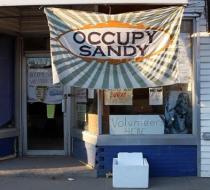Occupy Sandy relief effort puts Occupy Wall Street activists in the spotlight again a year after Zuccotti Park Favorite
By Rebecca Davis and Meena Hart Duerson
Those who believed the Occupy Wall Street movement was all but dead after its dramatic removal from Zuccotti Park last fall may have been surprised to see the group pop up again in the days after Hurricane Sandy.
But this time, they weren’t organizing protests – they were calling on their large network to come to the aid of those hit hardest by the storm.
Brett Goldberg joined Occupy in October of 2011, and considers himself a full-time activist. In the aftermath of Sandy, as Occupy organizers launched a relief effort dubbed Occupy Sandy, Goldberg quickly pitched in at the group’s hub in Brooklyn’s St. Jacobi church.
“At the beginning the priority was flashlights, batteries, blankets and hot food,” Goldberg said. “I came in, started fielding questions and inquiries that were coming in on Twitter and Facebook, and then within a few days, because I was answering those questions, I started getting a big picture idea of what was going on. I started doing site coordination and that’s primarily what I’ve been doing since.”
Goldberg now helps coordinate volunteers at the church who take donations and hot meals out to Occupy Sandy satellite sites in the Rockaways, Staten Island, Coney Island, Sheepshead Bay, Gerritsen Beach and Red Hook. There are now at least 30 of these small hubs in the affected areas, and thousands of people have volunteered through Occupy.
Longtime activists like Jessica Roff weren’t surprised that Occupy quickly became a leader in the Sandy relief effort, viewing the shift from organizing in Zuccotti Park to community aid as a natural extension of the movement’s original mission.
“When we were down in the park those first couple of months, it really was a community that was really communal and really supportive of itself and of each other,” Roff said. “People’s needs were provided for in that park…And that’s what we’re doing out here, too. I don’t really think it’s that different.”
“What Occupy Sandy is doing is it’s making a lot of the Occupy organizing very tangible for people,” Goldberg said. “It is definitely bringing in people who never really connected with Occupy before but now it’s starting to click for them in a different way."
Occupy Sandy has drawn in volunteers who had no prior connection with Occupy Wall Street but were looking for a way to help, and has also provided an opportunity for sympathizers with the movement to return after scattering over the last year.
Chris Devlin, who has been volunteering on the ground in the Rockaways, was skeptical of the Occupy movement before becoming involved with Occupy Sandy but has since become more politically involved.
“I’ve been impressed,” he said. “As far as the next operation...ideology’s not really my big thing, so I wouldn’t be like, yes I will support everything that this group does, but I’m an ally.”
Devlin has even taken on an organizing role, and has started attending Occupy meetings – a step that doesn’t surprise Goldberg, who sees it as a natural progression.
“People come in as volunteers and very quickly become organizers, and then the next step as we continue to push politically is to take volunteers into organizers and then make them activists,” Goldberg said. “It’s the work that everyone has always wanted to do.”
But for committed activists, Occupy Sandy isn’t just about the relief effort – they see this as an opportunity to draw attention to the same message they’ve been delivering since their days at Zuccotti Park.
“Something hit New York, it feels very real, it feels very tangible, and people feel like there is a way that they can contribute without just donating a dollar to the Red Cross when they go to the ATM,” Goldberg said. “Our job while we’re doing this relief and recovery work is also to show people how this situation is inherently political.”
Whether or not community groups in areas impacted by Sandy agree with Occupy’s political agenda, they certainly welcome the help.
Semeo Deo, who has run the Action Center in the Rockaways for the last 12 years, says Occupy Sandy’s volunteers have made up a signification percentage of the help he’s received since the storm.
“My wife commented the other day, ‘I didn’t know what to think of Occupy until they started doing what they did,’” he said. “But since the storm we have got nothing but tremendous support from Occupy. Every single day they’re here with supplies, food and moral support...So they’ve been a tremendous help to us.”
Many involved with Occupy say this is the work they’ve wanted to see the group do for a long time, and hope it will continue.
“We’re kind of saying we’re here til we’re not needed anymore, but what exactly that means we don’t know yet,” Goldberg said. “The relief effort will hopefully not be needed after the next couple weeks, but recovery and rebuilding will go on for a very long time and our role in that will change and evolve. We may not necessarily be doing the construction work but we’ll be engaging with the communities and doing community building and helping community empowerment and community connections - that’s the role I hope we’ll still continue to play.”







